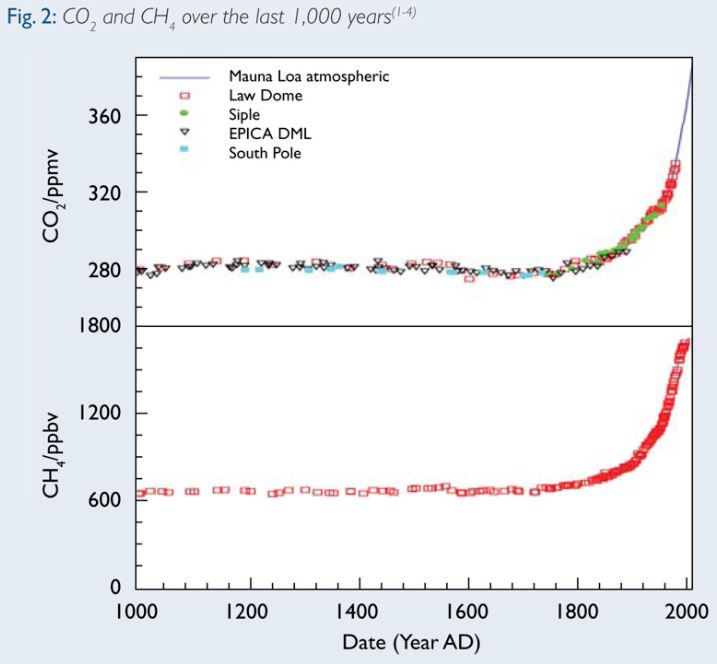How do we know so much about the climate in the past?
Honestly, how can be so certain about what happened in the air 10.000 years ago. Funny thing is that gas will be trapped in small pockets and drops in the ice while it freezes and get trapped by even more snow and ice. So thanks to ice samples drilled out from deep down in the ice of the Antarctic and Greenland. So scientists has drilled 3000 meters down and have been able to see the mixture of gases for around 800.000 years. And from the mixture we can also read the temperature. The amazing world of science and facts, as it can be checked, discussed and confirmed by others! Or discarded due to lack of reproducibility…
Thanks to scientist over a long period of time we have actual measurements from the 1950s (Charles Keeling) that we can use for control checking, as we know the actual content of the likes of CO2 and CH4 in the air, and compare and calibrate the content in ice cores as we can measure ice cores in the recent past. The most precise method for measuring the gas in melted ice cores in vacuum is Gas Chromatography (which is within my reach of technologies I work with), and have a precision of 0,4%, which tells us that they are very precise. More info here, but I warn you…
What they show us is that the sudden increase of CO2 for the last 100+ years is so much quicker than previous increases. The CO2 concentration increase in the last 20 years is equal to a 1000 year increase, compared to previous larger increases of CO2 over time. Same trend for the methane, CH4.

Figure above, the sudden increase of CO2 concentration above and CH4 below in the last 200 years.
We compare the patterns in the ice, different structures, with well known events and periods from other data and connect the ice level back 800.000 years. As major events like ice ages and volcanic eruptions will create signatures that we can recognize at certain levels.
Another interesting aspect in the ice cores is the measurements of different isotopes and how this can tell us the temperature, hydrogen isotopes like deuterium. What we also find in these ice cores are the link between CO2 concentrations and temperature over time, when the temperature is high, CO2 is high as well. These periods of cold and warmer air temperature is believed to be mostly influenced by the earths slightly changing orbit around the sun, but then with a slow rise over 1000 of years, not CO2 levels jumping as much as it has in a few decades…
The below linked article also show sudden events in past, but this is most likely to be local events, not affecting the whole globe. And this is always a bit tricky and can always affect our data, that is why we can listen to one scientist and should look for confirmations and constructive critics.
Have a lovely read, you find the details from the British Antarctic Survey below and the links to the actual publications, it is from 2014 and publicsations from even earlier, but the actual science is just as valid and other data confirms this. British Antarctic Survey has been controlling the Antarctica since before the 60s.
Data sources:
- MacFarling Meure, C., and others: Law Dome CO2, CH4 and N2O ice core records extended to 2,000 years BP, Geophys. Res. Lett., 33, L14810, doi:10.1029/2006GL026152, 2006
- Atmospheric data supplied by NOAA/ESRL
- Friedli, H., and others: Ice core record of the 13C/12C ratio of atmospheric CO2 in the past two centuries, Nature, 324, 237-238, 1986
- Siegenthaler, U., and others: Supporting evidence from the EPICA Dronning Maud Land ice core for atmospheric CO2 changes during the past millennium, Tellus Ser. B-Chem. Phys. Meteorol., 57, 51-57, 2005
- Jouzel, J., and others: Orbital and millennial Antarctic climate variability over the last 800,000 years, Science, 317, 793-796, 2007
- Lüthi, D., and others: High-resolution carbon dioxide concentration record 650,000-800,000 years before present, Nature, 453, 379-382, 2008
- Monnin, E., and others: Atmospheric CO2 concentrations over the last glacial termination, Science, 291, 112-114, 2001 with data converted to the age scale of Parrenin, F., and others: The EDC3 chronology for the EPICA Dome C ice core, Climate of the Past, 3, 485-497, 2007
- North Greenland Ice Core Project Members: High-resolution record of Northern Hemisphere climate extending into the last interglacial period, Nature, 431, 147-151, 2004
